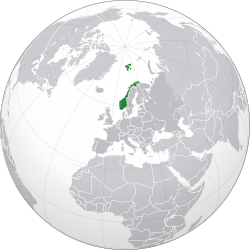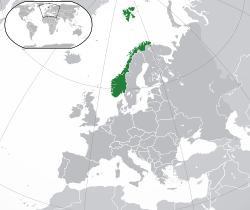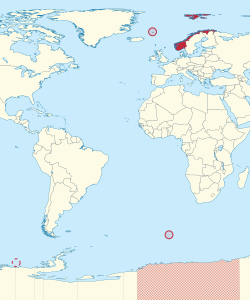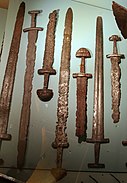
A | B | C | D | E | F | G | H | CH | I | J | K | L | M | N | O | P | Q | R | S | T | U | V | W | X | Y | Z | 0 | 1 | 2 | 3 | 4 | 5 | 6 | 7 | 8 | 9
Kingdom of Norway Kongeriket Norge (Bokmål) Kongeriket Noreg (Nynorsk) Other official names
| |
|---|---|
| Anthem: Ja, vi elsker dette landet (English: "Yes, we love this country") | |
Location of the Kingdom of Norway (green) in Europe (green and dark grey) | |
| Capital and largest city | Oslo 59°56′N 10°41′E / 59.933°N 10.683°E |
| Official languages | |
| Recognised national languages | |
| Ethnic groups |
|
| Religion |
|
| Demonym(s) | Norwegian |
| Government | Unitary parliamentary constitutional monarchy |
• Monarch | Harald V |
| Jonas Gahr Støre | |
| Masud Gharahkhani | |
| Toril Marie Øie | |
| Legislature | Storting |
| History | |
| 872 | |
• Old Kingdom of Norway (Peak extent) | 1263 |
| 1397 | |
| 1524 | |
| 25 February 1814 | |
| 17 May 1814 | |
| 4 November 1814 | |
| 7 June 1905 | |
| Area | |
• Total | 385,207 km2 (148,729 sq mi)[12] (61stb) |
• Water (%) | 5.32 (2015)[13] |
| Population | |
• 2024 estimate | |
• Density | 14.4/km2 (37.3/sq mi) (213th) |
| GDP (PPP) | 2024 estimate |
• Total | |
• Per capita | |
| GDP (nominal) | 2024 estimate |
• Total | |
• Per capita | |
| Gini (2020) | low |
| HDI (2022) | very high (2nd) |
| Currency | Norwegian krone (NOK) |
| Time zone | UTC+1 (CET) |
• Summer (DST) | UTC+2 (CEST) |
| Date format | dd.mm.yyyy |
| Driving side | right |
| Calling code | +47 |
| ISO 3166 code | NO |
| Internet TLD | .nod |
| |
Norway (Bokmål: Norge, Nynorsk: Noreg), formally the Kingdom of Norway,[a] is a Nordic country in Northern Europe, situated on the Scandinavian Peninsula. The remote Arctic island of Jan Mayen and the archipelago of Svalbard also form part of Norway.[note 5] Bouvet Island, located in the Subantarctic, is a dependency; Norway also claims the Antarctic territories of Peter I Island and Queen Maud Land. The capital and largest city in Norway is Oslo.
Norway has a total area of 385,207 square kilometres (148,729 sq mi)[12] and had a population of 5,488,984 in January 2023.[14] The country shares a long eastern border with Sweden. It is bordered by Finland and Russia to the northeast and the Skagerrak strait to the south. Norway has an extensive coastline facing the North Atlantic Ocean and the Barents Sea. Harald V of the House of Glücksburg is the current King of Norway. Jonas Gahr Støre has been Prime Minister of Norway since 2021. As a unitary state with a constitutional monarchy, Norway divides state power between the parliament, the cabinet, and the supreme court, as determined by the 1814 constitution. The unified kingdom of Norway was established in 872 as a merger of petty kingdoms and has existed continuously for 1151–1152 years. From 1537 to 1814, Norway was part of Denmark–Norway, and, from 1814 to 1905, it was in a personal union with Sweden. Norway was neutral during the First World War, and in the Second World War until April 1940 when it was invaded and occupied by Nazi Germany until the end of the war.
Norway has both administrative and political subdivisions on two levels: counties and municipalities. The Sámi people have a certain amount of self-determination and influence over traditional territories through the Sámi Parliament and the Finnmark Act. Norway maintains close ties with the European Union and the United States. Norway is a founding member of the United Nations, NATO, the European Free Trade Association, the Council of Europe, the Antarctic Treaty, and the Nordic Council; a member of the European Economic Area, the WTO, and the OECD; and a part of the Schengen Area. The Norwegian dialects share mutual intelligibility with Danish and Swedish.
Norway maintains the Nordic welfare model with universal health care and a comprehensive social security system, and its values are rooted in egalitarian ideals.[20] The Norwegian state has large ownership positions in key industrial sectors, having extensive reserves of petroleum, natural gas, minerals, lumber, seafood, and fresh water. The petroleum industry accounts for around a quarter of the country's gross domestic product (GDP).[21] On a per-capita basis, Norway is the world's largest producer of oil and natural gas outside of the Middle East.[22][23] The country has the fourth- and eight highest per-capita income in the world on the World Bank's and IMF's list, respectively.[24] It has the world's largest sovereign wealth fund, with a value of US$1.3 trillion.[25][26]
Etymology

Norway has two official names: Norge in Bokmål and Noreg in Nynorsk. The English name Norway comes from the Old English word Norþweg mentioned in 880, meaning "northern way" or "way leading to the north", which is how the Anglo-Saxons referred to the coastline of Atlantic Norway.[27][28][29] The Anglo-Saxons of Britain also referred to the kingdom of Norway in 880 as Norðmanna land.[27][28]
There is some disagreement about whether the native name of Norway originally had the same etymology as the English form. According to the traditional dominant view, the first component was originally norðr, a cognate of English north, so the full name was Norðr vegr, "the way northwards", referring to the sailing route along the Norwegian coast, and contrasting with suðrvegar "southern way" (from Old Norse suðr) for (Germany), and austrvegr "eastern way" (from austr) for the Baltic.[30]
History
Prehistory
The earliest traces of human occupation in Norway are found along the coast, where the huge ice shelf of the last ice age first melted between 11,000 and 8,000 BC. The oldest finds are stone tools dating from 9,500 to 6,000 BC, discovered in Finnmark (Komsa culture) in the north and Rogaland (Fosna culture) in the southwest. Theories about the two cultures being separate were deemed obsolete in the 1970s.[31]
Between 3000 and 2500 BC, new settlers (Corded Ware culture) arrived in eastern Norway. They were Indo-European farmers who grew grain and kept livestock, and gradually replaced the hunting-fishing population of the west coast.
Metal Ages
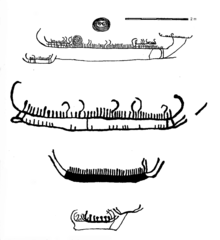
From about 1500 BC, bronze was gradually introduced. Burial cairns built close to the sea as far north as Harstad and also inland in the south are characteristic of this period, with rock carving motifs that differ from those of the Stone Age, depicting ships resembling the Hjortspring boat, while large stone burial monuments known as stone ships were also erected.[32]
There is little archaeological evidence dating to the early Iron Age (the last 500 years BC). The dead were cremated, and their graves contained few goods. During the first four centuries AD, the people of Norway were in contact with Roman-occupied Gaul; about 70 Roman bronze cauldrons, often used as burial urns, have been found. Contact with countries farther south brought a knowledge of runes; the oldest known Norwegian runic inscription dates from the third century.
Viking Age
By the time of the first historical records of Scandinavia, about the 8th century, several small political entities existed in Norway. It has been estimated that there were nine petty realms in Western Norway during the early Viking Age.[33] Archaeologist Bergljot Solberg on this basis estimates that there would have been at least 20 in the whole country.[34]
In the Viking period, Norwegian Viking explorers discovered Iceland by accident in the ninth century when heading for the Faroe Islands, and eventually came across Vinland, known today as Newfoundland, in Canada. The Vikings from Norway were most active in the northern and western British Isles and eastern North America isles.[35]
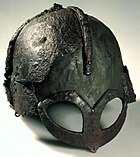
According to tradition, Harald Fairhair unified them into one in 872 after the Battle of Hafrsfjord in Stavanger, thus becoming the first king of a united Norway.[36] Harald's realm was mainly a South Norwegian coastal state. Fairhair ruled with a strong hand and according to the sagas, many Norwegians left the country to live in Iceland, the Faroe Islands, Greenland, and parts of Britain and Ireland.[37]
Haakon I the Good was Norway's first Christian king, in the mid-10th century, though his attempt to introduce the religion was rejected. Norse traditions were replaced slowly by Christian ones in the late 10th and early 11th centuries. This is largely attributed to the missionary kings Olaf I Tryggvasson and Olaf II Haraldsson (St. Olaf). Olaf Tryggvasson conducted raids in England, including attacking London. Arriving back in Norway in 995, Olaf landed in Moster where he built a church which became the first Christian church in Norway. From Moster, Olaf sailed north to Trondheim where he was proclaimed King of Norway by the Eyrathing in 995.[38] One of the most important sources for the history of the 11th century Vikings is the treaty between the Icelanders and Olaf II Haraldsson, king of Norway circa 1015 to 1028.[39]
Feudalism never really developed in Norway or Sweden, as it did in the rest of Europe. However, the administration of government took on a very conservative feudal character. The Hanseatic League forced royalty to cede to them greater and greater concessions over foreign trade and the economy, because of the loans the Hansa had made to the royals and the large debt the kings were carrying. The League's monopolistic control over the economy of Norway put pressure on all classes, especially the peasantry, to the degree that no real burgher class existed in Norway.[40]
High Middle Ages

From the 1040s to 1130, the country was at peace.[41] In 1130, the civil war era broke out on the basis of unclear succession laws, which allowed the king's sons to rule jointly. The Archdiocese of Nidaros was created in 1152 and attempted to control the appointment of kings.[42] The church inevitably had to take sides in the conflicts. The wars ended in 1217 with the appointment of Håkon IV Håkonsson, who introduced clear laws of succession.[43]
From 1000 to 1300, the population increased from 150,000 to 400,000, resulting both in more land being cleared and the subdivision of farms. While in the Viking Age farmers owned their own land, by 1300, seventy per cent of the land was owned by the king, the church, or the aristocracy, and about twenty per cent of yields went to these landowners.[44]
The 14th century is described as Norway's golden age, with peace and increase in trade, especially with the British Islands, although Germany became increasingly important towards the end of the century. Throughout the High Middle Ages, the king established Norway as a sovereign state with a central administration and local representatives.[45]
In 1349, the Black Death spread to Norway and within a year killed a third of the population. Later plagues reduced the population to half the starting point by 1400. Many communities were entirely wiped out, resulting in an abundance of land, allowing farmers to switch to more animal husbandry. The reduction in taxes weakened the king's position,[46] and many aristocrats lost the basis for their surplus. High tithes to church made it increasingly powerful and the archbishop became a member of the Council of State.[47]

The Hanseatic League took control over Norwegian trade during the 14th century and established a trading centre in Bergen. In 1380, Olaf Haakonsson inherited both the Norwegian (as Olaf IV) and Danish thrones (as Olaf II), creating a union between the two countries.[47] In 1397, under Margaret I, the Kalmar Union was created between the three Scandinavian countries. She waged war against the Germans, resulting in a trade blockade and higher taxation on Norwegian goods, which led to a rebellion. However, the Norwegian Council of State was too weak to pull out of the union.[48]
Margaret pursued a centralising policy which inevitably favoured Denmark because of its greater population.[49] Margaret also granted trade privileges to the Hanseatic merchants of Lübeck in Bergen in return for recognition of her rule, and these hurt the Norwegian economy. The Hanseatic merchants formed a state within a state in Bergen for generations.[50] The "Victual Brothers" launched three devastating pirate raids on the port (the last in 1427).[51]
Norway slipped ever more to the background under the Oldenburg dynasty (established 1448). There was one revolt under Knut Alvsson in 1502.[52] Norway took no part in the events which led to Swedish independence from Denmark in the 1520s.[53]
Kalmar Union
Upon the death of King Haakon V in 1319, Magnus Erikson, at just three years old, inherited the throne as King Magnus VII. A simultaneous movement to make Magnus King of Sweden proved successful (he was a grandson of King Magnus III of Sweden), and both the kings of Sweden and of Denmark were elected to the throne by their respective nobles. Thus Sweden and Norway were united under King Magnus VII.[54]
In 1349, the Black Death killed between 50% and 60% of Norway's population[55] and led to a period of social and economic decline.[56] Although the death rate was comparable with the rest of Europe, economic recovery took much longer because of the small, scattered population.[56] Even before the plague, the population was only about 500,000.[57] After the plague, many farms lay idle while the population slowly increased.[56] However, the few surviving farms' tenants found their bargaining positions with their landlords greatly strengthened.[56]

King Magnus VII ruled Norway until 1350, when his son, Haakon, was placed on the throne as Haakon VI.[58] In 1363, Haakon married Margaret, daughter of King Valdemar IV of Denmark.[56] Upon the death of Haakon in 1379, his 10-year-old son Olaf IV acceded to the throne.[56] As Olaf had already been elected to the throne of Denmark in 1376,[56] Denmark and Norway entered a personal union.[59] Olaf's mother and Haakon's widow, Queen Margaret, managed the foreign affairs of Denmark and Norway during Olaf's minority.[56]
Margaret was on the verge of achieving a union of Sweden with Denmark and Norway when Olaf IV suddenly died.[56] Denmark made Margaret temporary ruler on the death of Olaf. On 2 February 1388, Norway followed suit and crowned Margaret.[56] Queen Margaret knew that her power would be more secure if she were able to find a king to rule in her place. She settled on Eric of Pomerania, grandson of her sister. Thus at an all-Scandinavian meeting held at Kalmar, Erik of Pomerania was crowned king of all three Scandinavian countries, bringing the thrones of Norway, Denmark, and Sweden under the control of Queen Margaret when the country entered into the Kalmar Union.
Early modern period
After Sweden broke out of the Kalmar Union in 1521, Norway tried to follow suit, [citation needed] but the subsequent rebellion was defeated, and Norway remained in a union with Denmark until 1814. This period was by some referred to as the "400-Year Night", since all of the kingdom's intellectual and administrative power was centred in Copenhagen.
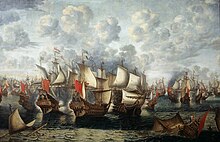
With the introduction of Protestantism in 1536, the archbishopric in Trondheim was dissolved; Norway lost its independence and effectually became a colony of Denmark. The Church's incomes and possessions were instead redirected to the court in Copenhagen. Norway lost the steady stream of pilgrims to the relics of St. Olav at the Nidaros shrine, and with them, much of the contact with cultural and economic life in the rest of Europe.
Eventually restored as a kingdom (albeit in legislative union with Denmark) in 1661, Norway saw its land area decrease in the 17th century with the loss of the provinces Båhuslen, Jemtland, and Herjedalen to Sweden, as the result of a number of disastrous wars with Sweden. In the north, its territory was increased by the acquisition of the northern provinces of Troms and Finnmark, at the expense of Sweden and Russia.
The famine of 1695–1696 killed roughly 10% of Norway's population.[60] The harvest failed in Scandinavia at least nine times between 1740 and 1800, with great loss of life.[61]
Later modern period
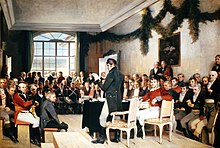
After Denmark–Norway was attacked by the United Kingdom at the 1807 Battle of Copenhagen, it entered into an alliance with Napoleon, with the war leading to dire conditions and mass starvation in 1812. As the Danish kingdom was on the losing side in 1814, it was forced by the Treaty of Kiel to cede Norway to Sweden, while the old Norwegian provinces of Iceland, Greenland, and the Faroe Islands remained with the Danish crown.[62] Norway took this opportunity to declare independence, adopted a constitution based on American and French models, and elected the Crown Prince of Denmark and Norway, Christian Frederick, as king on 17 May 1814 – celebrated as the Syttende mai (Seventeenth of May) holiday.
Norwegian opposition to the decision to link Norway with Sweden caused the Norwegian–Swedish War to break out as Sweden tried to subdue Norway by military means. As Sweden's military was not strong enough to defeat the Norwegian forces outright, and Norway's treasury was not large enough to support a protracted war, and as British and Russian navies blockaded the Norwegian coast,[63] the belligerents were forced to negotiate the Convention of Moss. Christian Frederik abdicated the Norwegian throne and authorised the Parliament of Norway to make the necessary constitutional amendments to allow for the personal union that Norway was forced to accept. On 4 November 1814, the Parliament (Storting) elected Charles XIII of Sweden as king of Norway, thereby establishing the union with Sweden.[64] Under this arrangement, Norway kept its liberal constitution and its own independent institutions, though it shared a monarch and foreign policy with Sweden. Following the recession caused by the Napoleonic Wars, economic development of Norway remained slow until 1830.[65]
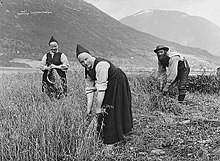
This period also saw the rise of Norwegian romantic nationalism, as Norwegians sought to define and express a distinct national character. The movement covered all branches of culture, including literature (Henrik Wergeland, Bjørnstjerne Bjørnson, Peter Christen Asbjørnsen, Jørgen Moe), painting (Hans Gude, Adolph Tidemand), music (Edvard Grieg), and even language policy, where attempts to define a native written language for Norway led to today's two official written forms for Norwegian: Bokmål and Nynorsk.
King Charles III John came to the throne of Norway and Sweden in 1818 and reigned to 1844. He protected the constitution and liberties of Norway and Sweden during the age of Metternich.[neutrality is disputed] As such, he was regarded as a liberal monarch. However, he was ruthless in his use of paid informers, secret police and restrictions on the freedom of the press to put down public movements for reform—especially the Norwegian national independence movement.[66]
The Romantic Era that followed the reign of Charles III John brought some significant social and political reforms. In 1854, women won the right to inherit property. In 1863, the last trace of keeping unmarried women in the status of minors was removed. Furthermore, women were eligible for different occupations, particularly the common school teacher.[67] By mid-century, Norway's democracy was limited; voting was limited to officials, property owners, leaseholders and burghers of incorporated towns.[68]

Norway remained a conservative society. Life in Norway (especially economic life) was "dominated by the aristocracy of professional men who filled most of the important posts in the central government".[69] There was no strong bourgeosie class to demand a breakdown of this aristocratic control.[70] Thus, even while revolution swept over most of the countries of Europe in 1848, Norway was largely unaffected.[70]
Marcus Thrane was a Utopian socialist who in 1848 organised a labour society in Drammen. In just a few months, this society had a membership of 500 and was publishing its own newspaper. Within two years, 300 societies had been organised all over Norway, with a total membership of 20,000 drawn from the lower classes of both urban and rural areas.[71] In the end, the revolt was easily crushed; Thrane was captured and jailed.[72]
In 1898, all men were granted universal suffrage, followed by all women in 1913.
Dissolution of the union and the First World War
Christian Michelsen, Prime Minister of Norway from 1905 to 1907, played a central role in the peaceful separation of Norway from Sweden on 7 June 1905. A national referendum confirmed the people's preference for a monarchy over a republic. However, no Norwegian could legitimately claim the throne, since none of Norway's noble families could claim royal descent.
The government then offered the throne of Norway to Prince Carl of Denmark, a prince of the Dano-German royal house of Schleswig-Holstein-Sonderburg-Glücksburg and a distant relative of Norway's medieval kings. Following the plebiscite, he was unanimously elected king by the Norwegian Parliament; he took the name Haakon VII.
Throughout the First World War, Norway remained neutral; however, diplomatic pressure from the British government meant that it heavily favoured the Allies. During the war, Norway exported fish to both Germany and Britain, until an ultimatum from the British government and anti-German sentiments as a result of German submarines targeting Norwegian merchantmen led to a termination of trade with Germany. 436 Norwegian merchantmen were sunk by the Kaiserliche Marine, with 1,150 Norwegian sailors killed.[73][disputed ]
Second World War
Norway once more proclaimed its neutrality during the Second World War, but was invaded by German forces on 9 April 1940. Although Norway was unprepared for the German surprise attack (see: Battle of Drøbak Sound, Norwegian Campaign, and Invasion of Norway), military and naval resistance lasted for two months. Norwegian armed forces in the north launched an offensive against the German forces in the Battles of Narvik, but were forced to surrender on 10 June after losing British support which had been diverted to France during the German invasion of France.

King Haakon and the Norwegian government escaped to Rotherhithe in London. Throughout the war they sent radio speeches and supported clandestine military actions against the Germans. On the day of the invasion, the leader of the small National-Socialist party Nasjonal Samling, Vidkun Quisling, tried to seize power, but was forced by the German occupiers to step aside. Real power was wielded by the leader of the German occupation authority, Josef Terboven. Quisling, as minister president, later formed a collaborationist government under German control. Up to 15,000 Norwegians volunteered to fight in German units, including the Waffen-SS.[74]
Many Norwegians and persons of Norwegian descent joined the Allied forces as well as the Free Norwegian Forces. In June 1940, a small group had left Norway following their king to Britain. This group included 13 ships, five aircraft, and 500 men from the Royal Norwegian Navy. By the end of the war, the force had grown to 58 ships and 7,500 men in service in the Royal Norwegian Navy, 5 squadrons of aircraft in the newly formed Norwegian Air Force, and land forces including the Norwegian Independent Company 1 and 5 Troop as well as No. 10 Commandos.[citation needed]
During German occupation, Norwegians built a resistance movement which incorporated civil disobedience and armed resistance including the destruction of Norsk Hydro's heavy water plant and stockpile of heavy water at Vemork, which crippled the German nuclear programme. More important to the Allied war effort, however, was the role of the Norwegian Merchant Marine, the fourth-largest merchant marine fleet in the world. It was led by the Norwegian shipping company Nortraship under the Allies throughout the war and took part in every war operation from the evacuation of Dunkirk to the Normandy landings. Every December Norway gives a Christmas tree to the United Kingdom as thanks for the British assistance during the war.[75]
Svalbard was not occupied by German troops, but Germany secretly established a meteorological station there in 1944.[76]
Post-World War II history
From 1945 to 1962, the Labour Party held an absolute majority in the parliament. The government, led by prime minister Einar Gerhardsen, embarked on a programme inspired by Keynesian economics, emphasising state financed industrialisation and co-operation between trade unions and employers' organisations. Many measures of state control of the economy imposed during the war were continued, although the rationing of dairy products was lifted in 1949, while price controls and rationing of housing and cars continued until 1960.
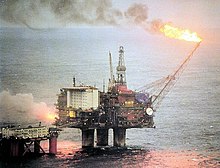
The wartime alliance with the United Kingdom and the United States continued in the post-war years. Although pursuing the goal of a socialist economy, the Labour Party distanced itself from the Communists, especially after the Communists' seizure of power in Czechoslovakia in 1948, and strengthened its foreign policy and defence policy ties with the US. Norway received Marshall Plan aid from the United States starting in 1947, joined the Organisation for Economic Co-operation and Development (OECD) one year later, and became a founding member of the North Atlantic Treaty Organization (NATO) in 1949.
Oil was discovered at the small Balder field in 1967, but production only began in 1999.[77] In 1969, the Phillips Petroleum Company discovered petroleum resources at the Ekofisk field west of Norway. In 1973, the Norwegian government founded the State oil company, Statoil (now Equinor). Oil production did not provide net income until the early 1980s because of the large capital investment required. Around 1975, both the proportion and absolute number of workers in industry peaked. Since then labour-intensive industries and services like factory mass production and shipping have largely been outsourced.
Norway was a founding member of the European Free Trade Association (EFTA). Norway was twice invited to join the European Union, but ultimately declined after referendums that failed by narrow margins in 1972 and 1994.[78]

In 1981, a Conservative Party government led by Kåre Willoch replaced the Labour Party with a policy of stimulating the stagflated economy with tax cuts, economic liberalisation, deregulation of markets, and measures to curb record-high inflation (13.6% in 1981).
Norway's first female prime minister Gro Harlem Brundtland of the Labour Party continued many of the reforms, while backing traditional Labour concerns such as social security, high taxes, the industrialisation of nature, and feminism. By the late 1990s, Norway had paid off its foreign debt and had started accumulating a sovereign wealth fund. Since the 1990s, a divisive question in politics has been how much of the income from petroleum production the government should spend, and how much it should save.
In 2011, Norway suffered two terrorist attacks by Anders Behring Breivik which struck the government quarter in Oslo and a summer camp of the Labour party's youth movement at Utøya island, resulting in 77 deaths and 319 wounded.[79]
Jens Stoltenberg led Norway as prime minister for eight years from 2005 to 2013.[80] The 2013 Norwegian parliamentary election brought a more conservative government to power, with the Conservative Party and the Progress Party winning 43% of the electorate's votes.[81] In the Norwegian parliamentary election 2017 the centre-right government of Prime Minister Erna Solberg won re-election.[82] The 2021 Norwegian parliamentary election saw a big win for the left-wing opposition in an election fought on climate change, inequality, and oil;[83] Labour leader Jonas Gahr Støre was sworn in as prime minister.[84]
Geography

Norway's core territory comprises the western and northernmost portion of the Scandinavian Peninsula; the remote island of Jan Mayen and the archipelago of Svalbard are also included.[note 5] The Antarctic Peter I Island and the sub-Antarctic Bouvet Island are dependent territories and thus not considered part of the Kingdom. Norway also claims a section of Antarctica known as Queen Maud Land.[85] Norwegian possessions in the North Atlantic, Faroe Islands, Greenland, and Iceland, remained Danish when Norway was passed to Sweden at the Treaty of Kiel.[86] Norway also comprised Bohuslän until 1658, Jämtland and Härjedalen until 1645,[85] Shetland and Orkney until 1468,[87] and the Hebrides and Isle of Man until the Treaty of Perth in 1266.[88]
Norway comprises the western and northernmost part of Scandinavia in Northern Europe,[89] between latitudes 57° and 81° N, and longitudes 4° and 32° E. Norway is the northernmost of the Nordic countries and if Svalbard is included also the easternmost.[90] Norway includes the northernmost point on the European mainland.[91] The rugged coastline is broken by huge fjords and thousands of islands. The coastal baseline is 2,532 kilometres (1,573 mi). The coastline of the mainland including fjords stretches 28,953 kilometres (17,991 mi), when islands are included the coastline has been estimated to 100,915 kilometres (62,706 mi).[92] Norway shares a 1,619-kilometre (1,006 mi) land border with Sweden, 727 kilometres (452 mi) with Finland, and 196 kilometres (122 mi) with Russia to the east. To the north, west and south, Norway is bordered by the Barents Sea, the Norwegian Sea, the North Sea, and Skagerrak.[93] The Scandinavian Mountains form much of the border with Sweden.
At 385,207 square kilometres (148,729 sq mi) (including Svalbard and Jan Mayen; 323,808 square kilometres (125,023 sq mi) without),[12] much of the country is dominated by mountainous or high terrain, with a great variety of natural features caused by prehistoric glaciers and varied topography. The most noticeable of these are the fjords. Sognefjorden is the world's second deepest fjord, and the world's longest at 204 kilometres (127 mi). Hornindalsvatnet is the deepest lake in Europe.[94] Norway has about 400,000 lakes[95][96] and 239,057 registered islands.[89] Permafrost can be found all year in the higher mountain areas and in the interior of Finnmark county. Numerous glaciers are found in Norway. The land is mostly made of hard granite and gneiss rock, but slate, sandstone, and limestone are also common, and the lowest elevations contain marine deposits.
Climate


Because of the Gulf Stream and prevailing westerlies, Norway experiences higher temperatures and more precipitation than expected at such northern latitudes, especially along the coast. The mainland experiences four distinct seasons, with colder winters and less precipitation inland. The northernmost part has a mostly maritime Subarctic climate, while Svalbard has an Arctic tundra climate. The southern and western parts of Norway, fully exposed to Atlantic storm fronts, experience more precipitation and have milder winters than the eastern and far northern parts. Areas to the east of the coastal mountains are in a rain shadow, and have lower rain and snow totals than the west. The lowlands around Oslo have the warmest summers, but also cold weather and snow in wintertime. The sunniest weather is along the south coast, but sometimes even the coast far north can be very sunny – the sunniest month with 430 sun hours was recorded in Tromsø.[97][98]
Because of Norway's high latitude, there are large seasonal variations in daylight. From late May to late July, the sun never completely descends beneath the horizon in areas north of the Arctic Circle, and the rest of the country experiences up to 20 hours of daylight per day. Conversely, from late November to late January, the sun never rises above the horizon in the north, and daylight hours are very short in the rest of the country.
Temperature anomalies found in coastal locations are exceptional, with southern Lofoten and Bø having all monthly means above freezing in spite of being north of the Arctic Circle. The very northernmost coast of Norway would be ice-covered in winter if not for the Gulf Stream.[99] The east of the country has a more continental climate, and the mountain ranges have subarctic and tundra climates. There is also higher rainfall in areas exposed to the Atlantic, especially the western slopes of the mountain ranges and areas close, such as Bergen. The valleys east of the mountain ranges are the driest; some of the valleys are sheltered by mountains in most directions. Saltdal (81 m) in Nordland is the driest place with 211 millimetres (8.3 inches) precipitation annually (1991–2020). In southern Norway, Skjåk in Innlandet get 295 millimetres (11.6 inches) precipitation. Finnmarksvidda and some interior valleys of Troms receive around 400 millimetres (16 inches) annually, and the high Arctic Longyearbyen 217 millimetres (8.5 inches).[100]
Parts of southeastern Norway including parts of Mjøsa have a humid continental climates (Köppen Dfb), while the southern and western coasts and also the coast north to Bodø have a oceanic climate (Cfb), while the outer coast further north almost to North Cape have a subpolar oceanic climate (Cfc). Further inland in the south and at higher altitudes, and also in much of Northern Norway, the subarctic climate (Dfc) dominates. A small strip of land along the coast east of North Cape (including Vardø) earlier had tundra/alpine/polar climate (ET), but this is mostly gone with the updated 1991–2020 climate normals, making this also subarctic. Large parts of Norway are covered by mountains and high altitude plateaus, and about one third of the land is above the treeline and thus exhibit tundra/alpine/polar climate (ET).[97][101][102][98][103]
Biodiversity

Norway has a larger number of different habitats than almost any other European country. There are approximately 60,000 species in Norway and adjacent waters (excluding bacteria and viruses). The Norwegian Shelf large marine ecosystem is considered highly productive.[104] The total number of species include 16,000 species of insects (probably 4,000 more species yet to be described), 20,000 species of algae, 1,800 species of lichen, 1,050 species of mosses, 2,800 species of vascular plants, up to 7,000 species of fungi, 450 species of birds (250 species nesting in Norway), 90 species of mammals, 45 fresh-water species of fish, 150 salt-water species of fish, 1,000 species of fresh-water invertebrates, and 3,500 species of salt-water invertebrates.[105] About 40,000 of these species have been described by science. The red list of 2010 encompasses 4,599 species.[106] Norway contains five terrestrial ecoregions: Sarmatic mixed forests, Scandinavian coastal conifer forests, Scandinavian and Russian taiga, Kola Peninsula tundra, and Scandinavian montane birch forest and grasslands.[107]
Seventeen species are listed mainly because they are endangered on a global scale, such as the European beaver, even if the population in Norway is not seen as endangered. The number of threatened and near-threatened species equals to 3,682; it includes 418 fungi species, many of which are closely associated with the small remaining old-growth forests,[108] 36 bird species, and 16 species of mammals. In 2010, 2,398 species were listed as endangered or vulnerable; of these were 1250 listed as vulnerable (VU), 871 as endangered (EN), and 276 species as critically endangered (CR), among which were the grey wolf, the Arctic fox, and the pool frog.[106]
The largest predator in Norwegian waters is the sperm whale, and the largest fish is the basking shark. The largest predator on land is the polar bear, while the brown bear is the largest predator on the Norwegian mainland. The largest land animal on the mainland is the elk (American English: moose).
Environment
Attractive and dramatic scenery and landscape are found throughout Norway.[109] The west coast of southern Norway and the coast of northern Norway present some of the most visually impressive coastal sceneries in the world. National Geographic has listed the Norwegian fjords as the world's top tourist attraction.[110] The country is also home to the natural phenomena of the Midnight sun (during summer), as well as the Aurora borealis known also as the Northern lights.[111]
Zdroj:https://en.wikipedia.org?pojem=Name_of_Norway
Text je dostupný za podmienok Creative Commons Attribution/Share-Alike License 3.0 Unported; prípadne za ďalších podmienok. Podrobnejšie informácie nájdete na stránke Podmienky použitia.
Antropológia
Aplikované vedy
Bibliometria
Dejiny vedy
Encyklopédie
Filozofia vedy
Forenzné vedy
Humanitné vedy
Knižničná veda
Kryogenika
Kryptológia
Kulturológia
Literárna veda
Medzidisciplinárne oblasti
Metódy kvantitatívnej analýzy
Metavedy
Metodika
Text je dostupný za podmienok Creative
Commons Attribution/Share-Alike License 3.0 Unported; prípadne za ďalších
podmienok.
Podrobnejšie informácie nájdete na stránke Podmienky
použitia.
www.astronomia.sk | www.biologia.sk | www.botanika.sk | www.dejiny.sk | www.economy.sk | www.elektrotechnika.sk | www.estetika.sk | www.farmakologia.sk | www.filozofia.sk | Fyzika | www.futurologia.sk | www.genetika.sk | www.chemia.sk | www.lingvistika.sk | www.politologia.sk | www.psychologia.sk | www.sexuologia.sk | www.sociologia.sk | www.veda.sk I www.zoologia.sk



